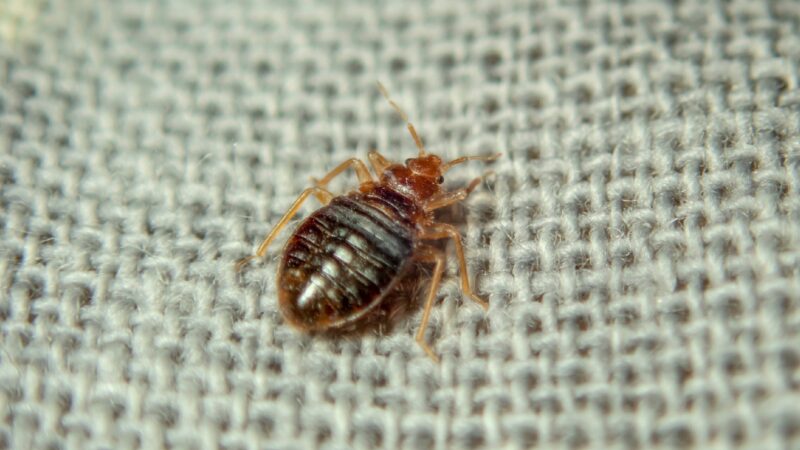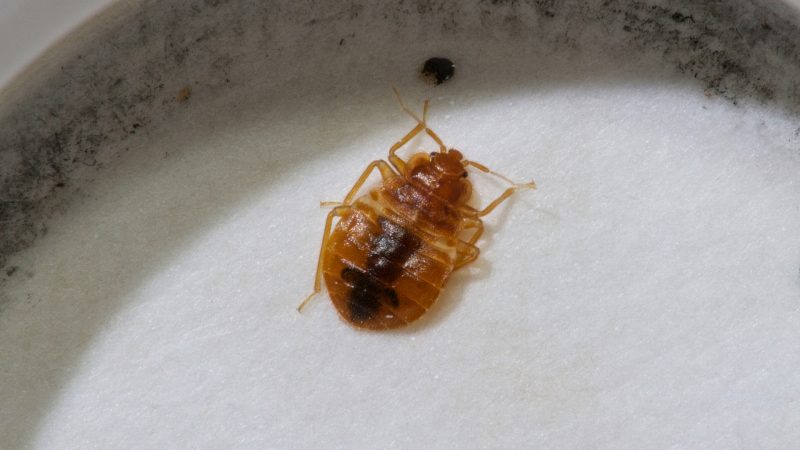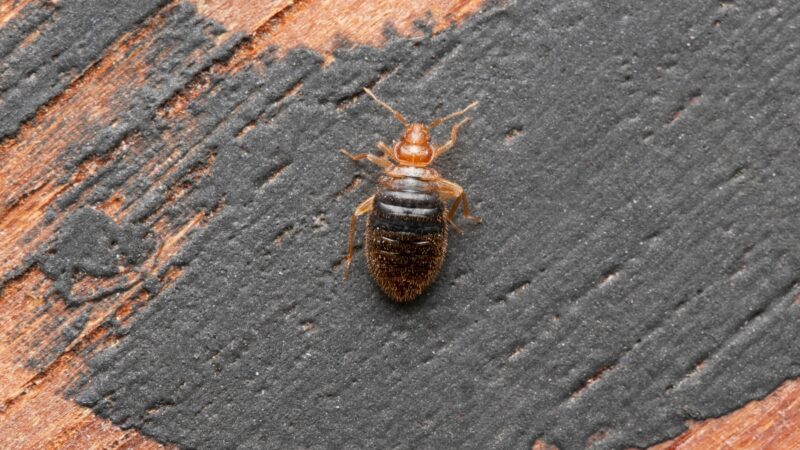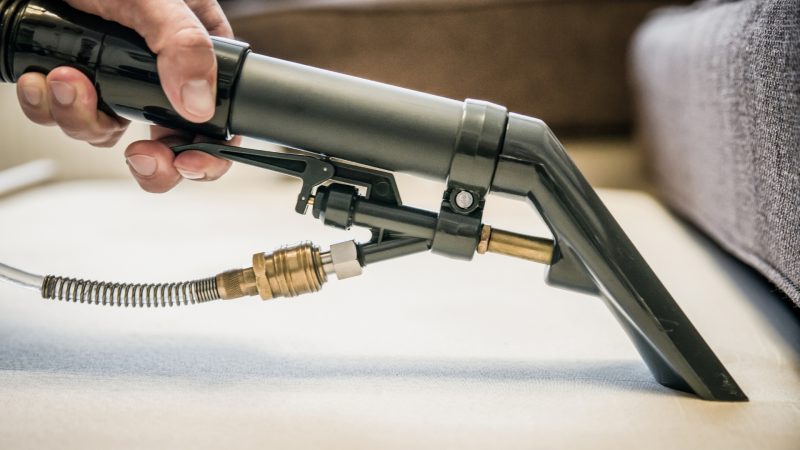Creatures that come out at night to feast on human blood sound like the plot of a horror movie. Unfortunately, this is the reality of bed bugs! But have no fear because understanding how these pests live and reproduce will help you identify and get rid of them.
So, do bed bugs build nests? Bed bugs don’t build nests. A female bed bug will lay her eggs almost anywhere. The most common place to find their eggs is in cracks and crevices within the area of infestation. However, females will also drop eggs while roaming to other areas.
To learn more about how bed bugs reproduce and their lifecycle, continue reading.
Lifecycle of Bed Bugs

Eggs can be laid both individually or in groups, depending on the female’s movement. She will lay between one to seven eggs per day. The eggs are visible to the naked eye (about the size of a pinhead) and take six to seventeen days to hatch.
Immediately after hatching, the nymphs will start searching for their first blood meal. It will be about 37 days before they reach maturity and are themselves able to reproduce. Within her lifetime, a female bed bug who feeds regularly can produce up to 250 eggs during her lifetime (in some cases up to 500 bed bug eggs).
After mating, females tend to wander to new territory to lay their eggs. Because there are no nests, eggs can be difficult to find. However, it is crucial to eliminate them along with the adult bed bugs.
How to Identify Bed Bug Eggs? | Signs to Look Out For
It is best to use a magnifying glass and thoroughly search your beds, couches, and anywhere people spend time resting for signs of bed bugs. This could also include items like clothes, carpets, wheelchairs, and office chairs. Female bed bugs will usually drop eggs relatively close to where their host rests, ensuring that their newly hatched nymphs will easily find their first meal.
However, it is also very important to check other typical bed bud hideouts: curtain folds, inside of the drawers, and box springs. The piping along mattress edges is another favorite place for bed bugs to hide and lay their eggs.
Look on every surface and crevice in the area you believe may be infested. The eggs are about one-tenth of an inch (two and a half millimeters) long. They are about the size of a grain of rice and are white or cream-colored.
If the eggs have developed into a later stage, you may even be able to see two small red eye dots on one end. The eggs may appear in groups and they will be sticky. It may be difficult to simply shake or brush them off. This is because the female bed bug leaves behind a glue-like substance when each egg is laid, ensuring that they stay in place.
This may make the area around the egg appear slightly wet if you look close enough. Also, be on the lookout for eggshells. The newly hatched bed bugs, called nymphs, will leave them behind. Nymphs are even smaller than eggs and are translucent in color. They will grow larger and darker as they move through their life stages and develop into mature adults.
What Do Adult Bed Bugs Look Like?

Bed bugs are medium brown to slightly red in color and about as big as an apple seed. Their bodies are flat and oval in shape, although they will appear more elongated and redder in color if they have been fed recently.
They have six legs and two antennae. Although bed bugs don’t have wings and cannot fly, you may see small “wing pads” on the backs of mature adults. Keep in mind that these insects have several stages in their life cycle. An infestation will include bed bugs at all life stages which may look slightly different from each other.
Other Signs of a Bed Bug Problem

If you suspect a bed bug infestation, there are other key signs to watch out for. Look for bite marks on the skin. Bite marks are red, and sometimes have a dark red spot in the middle. They will usually appear in either a line or cluster formation and will itch. Some people experience hives or blisters alongside the bites.
You may also find small, dark red blood stains on sheets or upholstery. Other signs of a bed bug problem are sheets or mattresses soiled with bed bug feces. The feces will appear black or rust-colored and are about the size of a pencil tip. You might also see the shed exoskeletons of bed bugs that have molted.
Do Bed Bugs Travel on People?
Unlike ticks or lice, bed bugs prefer not to remain on the human body after they’ve fed. The human body produces too much heat, driving the bed bugs away to a cooler area. This is why they are most likely to be transmitted from one place to another in backpacks, luggage, or secondhand furniture.
Can Bed Bugs Transmit Diseases to People?
Bed bugs have not been known to transmit diseases to people (except for a few cases related to their feces). However, because bed bug bites can itch, it is possible for a skin infection to develop due to too much scratching.
It is also possible to have an allergic reaction to the bites. It is important not to scratch the area! This will only irritate the skin and cause further issues.
Bites can be treated with an over-the-counter pain reliever, anti-itch creams, calamine lotions, or an oral antihistamine. See your doctor if your skin appears infected. He or she may prescribe an antibiotic.
Related: Are Bed Bug Bites Itchy? | Symptoms, Prevention, and Treatment
What to Do If You Have a Bed Bug Infestation?
If you do have a bed bug infestation, it is recommended that you contact a professional exterminator. However, if you’d rather take care of the problem yourself, there are a number of things you can do.
1. Vacuuming
First, try to determine which piece of furniture or area of your home is infected. If it’s your mattress, vacuum the mattress and treat it with an insecticide specifically made to kill bedbugs. When you’ve finished, enclose your mattress and box spring in encasement bags.
- Full 360° Protection: Unlike fitted sheet-style protectors that...
- 100% Waterproof: Advanced barrier keeps accidents, sweat, and...
- Quiet & Breathable Comfort: Soft, noiseless cotton fabric ensures...
- Durable & Secure Fit: High-quality zipper and strong stitching...
- Easy to Clean: Machine washable for effortless maintenance,...
This is done to prevent any surviving bed bugs from continuing the infestation. Leave the encasement bags on for a year, as bed bugs have been known to live up to 10 months without feeding.
If you decide to get rid of your mattress and buy a new one, be sure to keep the encasement on your old mattress before dragging it through your house and out the door. Otherwise, the surviving bed bugs may just find themselves a new home but in a different part of your house!
Now that the mattress is taken care of, it’s time to take care of the rest of the room and everything in it. Vacuum the room thoroughly. This includes all cracks and crevices, carpeted or not. After vacuuming, dispose of the vacuum cleaner bag to prevent these pests from finding their way out and back into your home.
2. Heat Treatment
Check any books in the infested room to ensure no bed bugs are hiding out there. All fabric items—including clothes, bedding, towels, and curtains—should be placed into a plastic bag and tied tightly until they can be washed. Wash all of your items at 130 degrees Fahrenheit (60 degrees Celsius). This will ensure that both the adult bed bugs and eggs will not survive the cycle.
Use a bed bug treatment laundry detergent. If possible, place your items in the dryer at a high temperature. Items that cannot be put in a washing machine can be placed in a dryer cycle at a minimum of 130 degrees. This will also kill bed bugs and their eggs. Long periods at high temperatures are key to eliminating these pests from your fabrics.
Related: How to Kill Bed Bugs with Heat Treatment? | Effective Strategies
How Can I Prevent Bed Bugs in My Home?

There are some basic things you can do to help prevent bed bugs from settling into your home. Vacuum frequently, and try to limit the amount of clutter in your living space. Frequent vacuuming and especially steaming will help remove any bugs that may have recently found their way inside, and less clutter means fewer places for bed bugs to hide.
You may also want to consider using a white mattress encasement, which will make it easier to see if any bed bugs are present. If you use a public laundry facility, place your freshly washed laundry directly into a bag and fold your clothes at home.
If you live in an apartment, you should seal any cracks or holes in your walls near light sockets and baseboards to prevent the movement of insects from one unit to another.
Also, be careful when bringing secondhand furniture into your home. Always check for signs of infestation first.
List of Sources
Sutherland, A. M., Choe, D. -H., Lewis, V. R. (2013). Bed Bugs. Agriculture and Natural Resources, University of California.
Rust, M. K. (2010). Fleas. Agriculture and Natural Resources, University of California.
Potter, M. F. (2018). Flea Control and Prevention. University of Kentucky.
- How to Get Rid of Copperheads | Practical Guide - August 27, 2023
- How to Get Rid of Corn Snakes | What Makes Them Aggressive? - August 27, 2023
- How to Get Rid of Alligators | Safety Measures and Removal Methods - July 16, 2023

